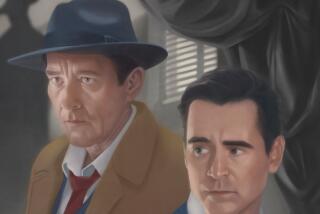‘Cider House’ Serves a Heady, Rich Brew
- Share via
“The Cider House Rules,” Lasse Hallstrom’s superb film adaptation of the acclaimed John Irving novel of the same name, takes its title from a short, typed list posted on the wall of an old building on a New England apple farm. The barn-like structure serves as a dormitory for migrant workers, and the list is composed of simple requests, such as not climbing on the roof of the Cider House to take a sun bath.
Self-evidently sensible, the rules nonetheless take on huge symbolic value in the course of the film, as its people keep discovering the chasm between the ideal, represented by that roster of arbitrary regulations, and the real, a distance they must navigate the best they can.
“Cider House,” however, does not begin at the apple farm but at St. Cloud’s Orphanage, a vast, shabby but magnificent Victorian structure in the Maine countryside. If St. Cloud’s might be a tad forbidding at first sight, it proves to be a haven of warmth, love and security, presided over for decades by sagacious, witty, loving and independent-thinking Dr. Wilbur Larch (Michael Caine in a career-crowning portrayal).
Dr. Larch early on decided that the point of living is “to be of use.” In the years 1943-45, in which “Cider House” mainly takes place, Dr. Larch, aided by the dedicated nurses Edna (Jane Alexander) and Angela (Kathy Baker), run the institution harmoniously, as they have for years. One of their charges, Homer Wells (Tobey Maguire), who never found a suitable adoptive family, became special to Dr. Larch and has grown up to be his assistant. Dr. Larch’s concept of being useful extends beyond delivering unwanted babies to performing abortions.
Homer is a serene, boyish-looking young man, educated entirely on the premises, who has never really been anywhere. It’s not that he doubts that the outside world is as harsh as Dr. Larch says it is; it’s that he has a healthy impulse to discover that for himself. When a young Air Force lieutenant, Wally Worthington (Paul Rudd), about to be dispatched to the Pacific theater, and his girlfriend Candy Kendall (Charlize Theron), two months pregnant, seek out Dr. Larch’s services, Homer departs with them, to take a job as an apple picker at Wally’s family farm, run by his mother (Kate Nelligan).
Armed with the rock-ribbed New England character of his upbringing at St. Cloud’s and a native intelligence, Homer has a family physician’s experience and knowledge, but is otherwise an innocent. Mrs. Worthington’s black laborers, headed by the patriarchal Mr. Rose (Delroy Lindo), are wary of a young white man sharing decidedly primitive quarters with them--remember that even the U.S. Armed Forces were still segregated at the time.
But Homer is so self-possessed, so direct in his gaze and manner, and so unpretentious as well, he is soon accepted by Mr. Rose and his small crew, which includes his pretty daughter Rose (Erykah Badu).
The Worthington farm is an easy train ride away from St. Cloud’s, but Homer has in fact entered that big outside world where people and their fates are a mass of contradictions. Homer is soon to learn that good and evil can reside within the same individual, that people’s lives can be altered in an instant through no fault of their own and that ultimately only individuals can make decisions as to what is the best course for their lives. It’s not that Homer hasn’t seen a lot at St. Cloud’s, starting with death, whether it’s that of a sickly child or a young girl who’s come to Dr. Larch suffering from a horribly botched abortion; it’s that he’s experienced it within the sheltering love and security of St. Cloud.
That Irving adapted his novel to the screen himself and, even more, that Hallstrom directed it, makes “Cider House” a far better film than other film adaptations of Irving’s work--”The Hotel New Hampshire” and “The World According to Garp.” In those films the characters seemed literary conceits instead of actual people--with the exception of John Lithgow’s unforgettable transsexual in “Garp.” Having Hallstrom direct is perfect casting. His “My Life as a Dog” revealed his astute way with children and their lives, and “What’s Eating Gilbert Grape” showed he could handle the tragicomic with assurance, and he puts both these strengths to splendid use in “Cider House.”
The opening sequences at St. Cloud’s, with its raft of adorable youngsters and their heart-tugging predicaments, presents a huge potential for sentimentality, just as Wally’s going off to war inevitably draws Homer and Candy closer. But Irving and Hallstrom move way beyond the seemingly predictable to ponder the way in which everyone must make his or her way through life’s constant interplay of choice and fate.
They’ve been aided immeasurably by a large cast in which everyone seems so well-suited that you don’t even want to think about anyone else in the roles. Maguire’s combination of ordinary, clean-cut looks and inner resources is just what Homer requires. And if you’re old enough to have been in grammar school during World War II, Theron strikes you as the archetypal pretty young woman of the era, the girl whom just about every young serviceman dreams of coming home to. Lindo suggests the full range of human behavior in his eloquent Mr. Rose, and Rudd is the handsome yet likable and responsible beau ideal.
*
Caine, in his understated yet towering portrayal, reveals in Dr. Larch the vulnerability that lurks within--and, indeed, informs--individuals of formidable resolve and strength of character. Sterling key support comes from the always notable Alexander, Baker and Nelligan and from newcomer Badu. Kieran Culkin, Heavy D, K. Todd Freeman and Paz de la Huerta head a long list of staunch featured players.
Ventfort Hall, the decaying 1893 Massachusetts summer cottage of J.P. Morgan’s sister Sarah, served as St. Cloud’s exterior and entry hall; its interiors were filmed in an abandoned state hospital. Production designer David Gropman took inspiration from Andrew Wyeth paintings of the era; cinematographer Oliver Stapleton created mellow, burnished images.
Renee Ehrlich Kalfus’ costumes are spot-on for time and place, and Rachel Portman’s soaring score supports but never overwhelms the story’s sweeping, ever-shifting emotional tides. “The Cider House Rules” looks to achieve that prized goal of combining prestige with popularity.
* MPAA rating: PG-13, for mature thematic elements, sexuality, nudity, substance abuse and some violence. Times guidelines: The film also has sequences depicting abortions discreetly but described forthrightly, and the entire film is too adult for children.
‘The Cider House Rules’
Tobey Maguire: Homer Wells
Michael Caine: Dr. Wilbur Larch
Charlize Theron: Candy Kendall
Delroy Lindo: Mr. Rose
Paul Rudd: Wally Worthington
A Miramax Films presentation of a Film Colony production. Director Lasse Hallstrom. Producer Richard N. Gladstein. Executive producers Bob Weinstein, Harvey Weinstein, Bobby Cohen, Meryl Poster. Screenplay by John Irving, from his novel. Cinematographer Oliver Stapleton. Editor Lisa Zeno Churgin. Music Rachel Portman. Costumes Renee Ehrlich Kalfus. Production designer David Gropman. Art director Karen Schulz-Gropman. Set decorator Beth Rubino. Running time: 2 hours, 5 minutes.
At selected theaters.
More to Read
Only good movies
Get the Indie Focus newsletter, Mark Olsen's weekly guide to the world of cinema.
You may occasionally receive promotional content from the Los Angeles Times.










